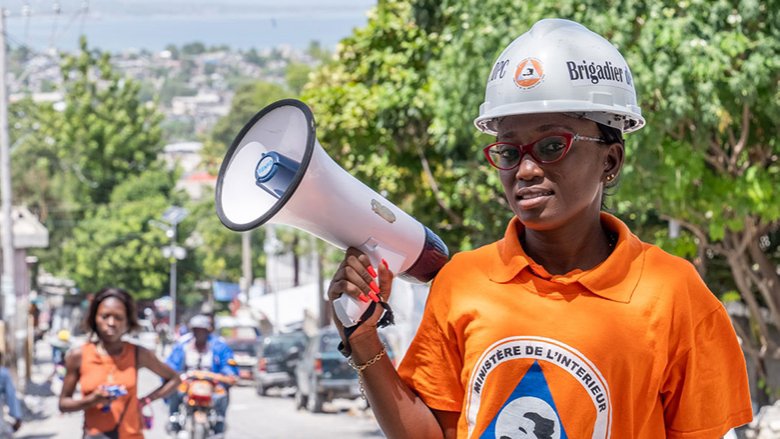Connecting Climate and Development and Tackling Both Together
2022 saw the first of the Bank Group’s pioneering Country Climate and Development Reports (CCDRs), a new core diagnostic which seeks to identify which strategies will do the most, the fastest, to reduce greenhouse gas (GHG) emissions in each individual country while achieving critical development goals. Over 20 of these have been published in the first year along with a comprehensive analysis of the first batch which found that countries can build resilience and achieve climate goals without compromising development, but this will require major changes. CCDRs also featured prominently at the Bank Group’s first ever standalone pavilion at COP27. See all the replays here.
Putting Women and Girls at the Heart of Climate Action
The low-carbon, resilient transformation is about people and, therefore, ensuring that these transitions benefit all people, will require a deliberate focus on addressing gender equality. That means ensuring that a gender sensitive approach is applied to boosting resilience and adaptive capacity, and to ensuring women and girls can more fully participate in the new climate economy of the future, for instance by ensuring they can access the right education and job-relevant skills. And it also means that women’s voices and leadership are incorporated into decision-making and climate governance at local and national levels and that gender equality is integrated into climate investments. Read more about how this is happening here.
Addressing the Challenge of Financing at Scale
Financing climate action requires trillions, even with the right policy environment. Only some of the investments that are needed can be delivered through private capital; many investments will require public support. Core to the challenge is that some of the needed interventions currently lack the incentives and capacities to make them happen, and may require concessional and/or grant financing, especially in low-income countries. What are the investments and interventions that can deliver high climate impact but require additional support? How much concessional finance is needed? Where are the possible sources of finance? Read about our thinking on it here.
Supporting Financing Approaches that Are Delivering Results
While most of international public climate finance is provided upfront before a project is operational, results-based climate finance is paid when results are achieved, and occasionally upon meeting interim milestones. Payments are made once pre-agreed targets have been met and, usually, once GHG emission reductions have been verified as real and additional – meaning they would not have occurred otherwise. The Bank has extensive experience in supporting results-based climate finance. At COP27, the Bank presented a new fund: SCALE, designed to pool resources from the global community and provide grant payments on a results basis to countries for lowering their emissions. SCALEs approach aims to incentivize the generation of high-quality carbon credits by client countries – which are paid for and can be used against NDCs. It will also help build capacity for countries to access carbon markets. And, thanks to the benefit sharing arrangements of the results-based climate finance approach, it ensures that the money flows to the people who are driving the low carbon transitions - including indigenous peoples, marginalized and disadvantaged communities. Find out more about SCALE here.
Strengthening our Approach to Building Resilience
The Bank now has a tool to support a comprehensive assessment of adaptation and resilience in countries. Drawing from the 6 Adaptation principles – namely, building resilient foundations through rapid and inclusive development, facilitating the adaptation of firms and people, adapting land use and protecting critical public assets and services, increasing people’s capacity to cope with and recover from shocks, anticipating and managing macroeconomic and fiscal risks and ensuring effective implementation with a robust governance structure and continuous monitoring - the tool evaluates each pillar and a set of action areas using a mix of quantitative and qualitative indicators to assess achievement, progress, and gaps in order to identify priority areas for intervention. The tool was used for CCDRs to help assess where progress is being made, or lagging. And it is also being applied in the Caribbean to help guide investments in infrastructure and peoples’ safety. Read more about it here.
Deep Dives into Sectors and Regions
2022 was a year of both mounting climate impacts and geopolitical tensions that threatened to derail climate action. The severity of climate impacts got much worse: extreme floods in Pakistan claimed hundreds of lives and displaced millions, droughts in China and the horn of Africa impacted millions, and scorching heatwaves hit Europe which saw its worst drought in 500 years. At the same time, the war in Ukraine, rocketing inflation, strained budgets and energy shortfalls caused fuel and food insecurity. The human consequences of these overlapping crises is catastrophic with profound implications for development. Telling these stories, understanding what the transition looks like for communities and countries, sometimes requires a long form approach, taking our readers on a journey. Check out the sectoral transformation here and visit the Congo basin, the lungs of Africa, here.

